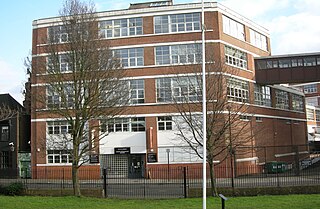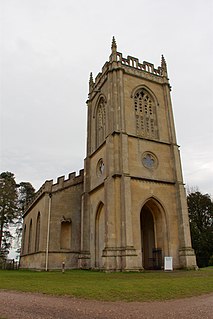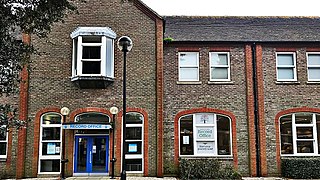Related Research Articles
Sir Henry Herbert was Master of the Revels to both King Charles I and King Charles II, as well as a politician during both reigns.

Earl of Coventry is a title that has been created twice in the Peerage of England. The first creation for the Villiers family was created in 1623 and took its name from the city of Coventry. It became extinct in 1687. A decade later, the second creation was for the Coventry family and is still extant.

The London Metropolitan Archives (LMA) is the principal local government archive repository for the Greater London area, including the City of London: it is the largest county record office in the United Kingdom. It was established under its present name in 1997, having previously been known as the Greater London Record Office. It is administered and financed by the City of London Corporation.

The Royal Archives, also known as the Queen's Archives, is a division of The Royal Household of the Sovereign of the United Kingdom. It is operationally under the control of the Keeper of the Royal Archives, who is customarily the Private Secretary to the Sovereign. Although Sovereigns have kept records for centuries, the Royal Archives was formally established as recently as 1912 and occupies part of the Round Tower of Windsor Castle. Since the Royal Archives are privately owned, requests for public access must be approved based on the needs and qualifications of the researcher.

Hocken Collections (Māori: Uare Taoka o Hākena, formerly the Hocken Library) is a research library, historical archive, and art gallery based in Dunedin, New Zealand. Its library collection, which is of national significance, is administered by the University of Otago.

Henry Cavendish, 2nd Duke of Newcastle-upon-Tyne, KG, PC, styled Lord Cavendish until 1676, and Viscount Mansfield from 1676, was an English politician who sat in the House of Commons from 1660 to 1676, and then inherited the dukedom.

The Modern Records Centre (MRC) is the specialist archive service of the University of Warwick in Coventry, England, located adjacent to the Central Campus Library. It was established in October 1973 and holds the world's largest archive collection on British industrial relations, as well as archives relating to many other aspects of British social, political and economic history.

The India Office Records are a very large collection of documents relating to the administration of India from 1600 to 1947, the period spanning Company and British rule in India. The archive is held in London by the British Library and is publicly accessible. It is complemented further by the India Papers collection at the National Library of Scotland in Edinburgh.

Croome Court is a mid-18th-century Neo-Palladian mansion surrounded by extensive landscaped parkland at Croome D'Abitot, near Upton-upon-Severn in south Worcestershire, England. The mansion and park were designed by Lancelot "Capability" Brown for the 6th Earl of Coventry, and they were Brown's first landscape design and first major architectural project. Some of the mansion's rooms were designed by Robert Adam. The Church of St Mary Magdalene that sits within the grounds of the park is owned and cared for by the Churches Conservation Trust.

Sir Thomas Phillipps, 1st Baronet, was an English antiquary and book collector who amassed the largest collection of manuscript material in the 19th century. He was an illegitimate son of a textile manufacturer and inherited a substantial estate, which he spent almost entirely on vellum manuscripts and, when out of funds, borrowed heavily to buy manuscripts, thereby putting his family deep into debt. Phillipps recorded in an early catalogue that his collection was instigated by reading various accounts of the destruction of valuable manuscripts. Such was his devotion that he acquired some 40,000 printed books and 60,000 manuscripts, arguably the largest collection a single individual has created, and coined the term "vello-maniac" to describe his obsession, which is more commonly termed bibliomania.

William Coventry, 5th Earl of Coventry, of London and later Croome Court, Worcestershire, was a British Whig politician who sat in the House of Commons from 1708 to 1719.
Manuscripts and Special Collections is part of Libraries, Research and Learning Resources at the University of Nottingham. It is based at King's Meadow Campus in Nottingham in England. The university has been collecting manuscripts since the early 1930s and now holds approximately 3 million documents, extensive holdings of Special Collections, and the East Midlands Collection of local material, all of which are available for researchers to use in the supervised Wolfson Reading Rooms.
The Borthwick Institute for Archives is the specialist archive service of the University of York, York, England. It is one of the biggest archive repositories outside London. The Borthwick was founded in 1953 as The Borthwick Institute of Historical Research. It was originally based at St Anthony's Hall, a fifteenth-century guild hall on Peasholme Green, in central York. Since 2005 it has been based in a purpose-built building, situated adjacent to the JB Morrell Library on the University of York's Heslington West campus. This new building was made possible due to a grant of £4.4 million by the Heritage Lottery Fund and designed by Leach Rhodes Walker and Buro Happold.

Sheffield Archives collects, preserves and lists records relating to Sheffield and South Yorkshire and makes them available for reference and research.
Worcestershire Record Office is located in Worcester, England, as a part of Worcestershire County Council. The Worcestershire Record Office comprises three branches, two of which are located in County Hall, the third at The Hive, Worcester.

Acceptance in lieu (AiL) is a provision in British tax law under which inheritance tax debts can be written off in exchange for the acquisition of objects of national importance. It was originally established by Chancellor of the Exchequer David Lloyd George as a means for the wealthy to pay the increased estate taxes imposed by his People's Budget of 1909 but had its roots in similar schemes dating to the late 19th century. It has developed from the early years, when it was used mainly as a means for the aristocracy to dispose of country estates to the National Trust, to the modern day, when it is more associated with the transfer of works of art, antiquities and archive material to museums. The scheme is administered by Arts Council England, a non-departmental public body of the Department for Culture, Media and Sport. The scheme has brought many houses, works of art and other collections into publicly accessible institutions when they would otherwise have gone to auction. In April 2013 the Cultural Gifts Scheme was started which allows taxpayers to make a donation of art in return for a credit on income tax, capital gains tax or corporation tax. The Cultural Gifts Scheme is also administered by Arts Council England and is reported jointly with the Acceptance in Lieu scheme.

St Mary Magdalene's Church is a former Anglican church in the grounds of Croome Court, at Croome D'Abitot, Worcestershire, England. It is recorded in the National Heritage List for England as a designated Grade I listed building, and is under the care of The Churches Conservation Trust. The church, which is dedicated to Jesus' companion Mary Magdalene, stands on a hill in Croome Park. Commenting on the church, the architectural historian Nikolaus Pevsner stated it is "one of the most serious of the Early Gothic Revival outside, one of the most elegant inside".
The Designation Scheme is an English system that awards "Designated status" to museum, library and archive collections of national and international importance. The Scheme is administered by Arts Council England (ACE). As of 2020, 152 collections are officially designated. National museums are not eligible for Designated status.

Mark Noble (1754–1827) was an English clergyman, biographer and antiquary.

The West Sussex Record Office at Orchard Street, Chichester, holds the archives for the county of West Sussex. It is run by West Sussex County Council.
References
- ↑ Museums, Libraries and Archives Council (MLA), Acceptance in Lieu Report 2005/06, (MLA), 2006 ISBN 1-905867-00-X
- ↑ Gordon, Catherine, The Coventrys of Croome, (Phillimore), 2000, ISBN 1-86077-139-4